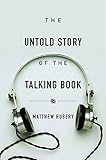The Untold Story of the Talking Book / Matthew Rubery.
Material type: TextPublisher: Cambridge, MA : Harvard University Press, [2017]Copyright date: ©2016Description: 1 online resource (360 p.) : 39 halftonesContent type:
TextPublisher: Cambridge, MA : Harvard University Press, [2017]Copyright date: ©2016Description: 1 online resource (360 p.) : 39 halftonesContent type: - 9780674974555
- 002.09 23
- Z286.A83 R83 2016
- online - DeGruyter
| Item type | Current library | Call number | URL | Status | Notes | Barcode | |
|---|---|---|---|---|---|---|---|
 eBook
eBook
|
Biblioteca "Angelicum" Pont. Univ. S.Tommaso d'Aquino Nuvola online | online - DeGruyter (Browse shelf(Opens below)) | Online access | Not for loan (Accesso limitato) | Accesso per gli utenti autorizzati / Access for authorized users | (dgr)9780674974555 |
Frontmatter -- Contents -- Introduction: What Is the History of Audiobooks? -- Part I. The Phonographic Library -- 1. Canned Literature -- Part II. Blindness, Disability, and Talking Book Records -- 2. A Talking Book in Every Corner of Dark- Land -- 3. How to Read a Talking Book -- 4. A Free Press for the Blind -- 5. From Shell Shock to Shellac -- 6. Unrecordable -- Part III. Audiobooks on and off the Road -- 7. Caedmon’s Third Dimension -- 8. Tapeworms -- 9. Audio Revolution -- Afterword: Speed Listening -- Notes -- Credits -- Acknowledgments -- Index
restricted access online access with authorization star
http://purl.org/coar/access_right/c_16ec
Histories of the book often move straight from the codex to the digital screen. Left out of that familiar account are nearly 150 years of audio recordings. Recounting the fascinating history of audio-recorded literature, Matthew Rubery traces the path of innovation from Edison’s recitation of “Mary Had a Little Lamb” for his tinfoil phonograph in 1877, to the first novel-length talking books made for blinded World War I veterans, to today’s billion-dollar audiobook industry. The Untold Story of the Talking Book focuses on the social impact of audiobooks, not just the technological history, in telling a story of surprising and impassioned conflicts: from controversies over which books the Library of Congress selected to become talking books—yes to Kipling, no to Flaubert—to debates about what defines a reader. Delving into the vexed relationship between spoken and printed texts, Rubery argues that storytelling can be just as engaging with the ears as with the eyes, and that audiobooks deserve to be taken seriously. They are not mere derivatives of printed books but their own form of entertainment. We have come a long way from the era of sound recorded on wax cylinders, when people imagined one day hearing entire novels on mini-phonographs tucked inside their hats. Rubery tells the untold story of this incredible evolution and, in doing so, breaks from convention by treating audiobooks as a distinctively modern art form that has profoundly influenced the way we read.
Mode of access: Internet via World Wide Web.
In English.
Description based on online resource; title from PDF title page (publisher's Web site, viewed 24. Aug 2021)


